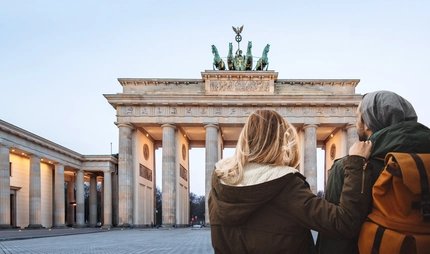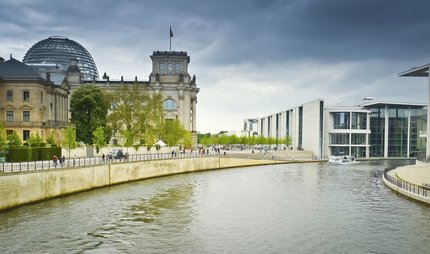
Reichstag in Berlin
Parliament and mirror of German history
The Reichstag bears silent witness to the turbulent history of Berlin and is one of the city’s most significant historical buildings.
Berlin is the city where German history is written. Where is the best place to experience it? Come and explore the Reichstag!
Reservations and tickets – how to visit the Reichstag
There are several options to visit the Reichstag:
- join a guided tour
- listen to a plenary session (in German of course)
- climb up to the dome and the roof
Online registration at the Bundestag (German parliament)
A quick look around or a detailed tour - both is possible but only with an advanced booking. For this, simply use the online form and you can find further information at bundestag.de.
Our tip: There are a lot of visitors to the Reichstag on weekends. If possible, it´s better to choose a time midweek.
Other tickets for tours in the Reichstag and government district

Enjoy a boat ride past the government district
Take photos of the Reichstag and the government district from the water on a boat trip through Berlin.
City tours and guided tours with Reichstag
Explore the government district and learn more about Berlin´s history and the architecture of the Reichstag building during a city tour.
Popular tickets among our visitors can be found at visitBerlin.de
Hop On / Hop Off - Bus tours with a stop at the Reichstag
Explore Berlin´s sights during the bus tour and get off directly at the Reichstag. Book your tickets directly at visitBerlin.de and avoid long queues in Berlin.
A short history of the Reichstag
The Reichstag is an internationally recognisable symbol of democracy and the current home of the German parliament. Every year, thousands of guests visit the Reichstag - and with good reason: It is not often that you can enjoy such an amazing panorama while, just beneath your feet, the political decisions of tomorrow are being made. Both as an architectural wonder and a historical testimony, the Reichstag has an important role to play in Berlin.

The original building is designed by Paul Wallot and modelled after the Memorial Hall in Philadelphia. Decorative motifs, sculptures and mosaics are contributed by the artist Otto Lessing. The Reichstag is completed in 1894 although it doesn’t acquire its iconic dedication to “the German People” until 1916 when the words Dem Deutschen Volke are inscribed on its façade. At the time Kaiser Wilhelm II regards the building as “the pinnacle of bad taste”.
The Reichstag serves as the home of the German parliament until 1933 when the building is badly damaged in a fire. This event marks the end of the Weimar Republic and provides a convenient pretext for Hitler to suppress dissent. Under Nazi dictatorship, the building falls into neglect and is severely damaged during the Second World War. In 1945 it becomes one of the primary targets for the Red Army due to its perceived propaganda value.
After the war, West Germany’s parliament is relocated to Bonn, and the building remains a virtual ruin until 1961 when a partial renovation is undertaken in the shadow of the newly erected Wall. Completed in 1964 this controversial restoration sees the building’s interior and exterior stripped of the majority of its statuary. However, the city makes efforts to retain the traces of its more recent history such as the bullet ridden façade and the graffiti left by the occupying Soviet soldiers.
Throughout the cold war period and until the German reunification in 1989 the Reichstag is the site of a permanent exhibition, “Questions about German History” but otherwise sees only occasional ceremonial use. In 1990 the Reichstag is the site of the official reunification ceremony. After another year of intense debate, it is decided that it will once again be the home of the German national parliament. In 1995, just prior to the commencement of Norman Foster’s restoration of the building, artist Christo and his wife Jeanne-Claude wrap the Reichstag in fabric. Foster’s careful restoration and redesign of the building is completed in 1999, and the new German government convenes at the Reichstag for the first time on April the 19th.
There is a certain irony in the fact that the building’s glass cupola is not featured in Foster’s original plans for the renovation of the Reichstag. The dome sits directly above the debating chamber. A mirrored cone at its centre directs light into the Reichstag, increasing the building’s energy efficiency and affording visitors a view of the parliamentary proceedings below. The dome itself can be visited by prior registration and is reached by two large steel ramps that curve up towards it in the form of a double helix.
Five fascinating facts about the Reichstag
- Cyrillic graffiti left by Soviet soldiers, after their siege of the Reichstag in 1945, has been carefully preserved and can be still seen by visitors today.
- A true example of eco-architecture, the Reichstag is highly self sufficient in its production of energy. The shape of the dome allows the building to make use of natural lighting and ventilation which makes the building a unique symbol of sustainability.
- The Reichstag is an important art venue. It has a considerable art collection and shows changing exhibitions as well as permanently installed artworks.
- The roof of the Reichstag is home to the Käfer Dachgarten Restaurant where guests with a prior reservation can enjoy a delicious breakfast, lunch or dinner. Free panoramic view included!
- Besides its eventful history, Berlin is known to be a casual and friendly city. See for yourself on the grass in front of the Reichstag. This is a perfect place for picnics and a popular spot for sunbathing and relaxing.
What to see nearby when you visit the Reichstag
There are a number of important Berlin landmarks situated in the immediate vicinity of the Reichstag. The main railway station, the Bundeskanzleramt and the Brandenburger Tor are all located a short walk away from the parliament building. You can also find a number of memorials nearby. These include the astounding Holocaust-Memorial by Peter Eisenman that consists of 2,711 concrete slabs arranged in a grid in which you can suddenly feel very disoriented and small. Another nearby memorial consisting of a circular pool commemorates the Sinti and Roma victims of National Socialism, whilst a concrete cube containing a video memorialises the homosexuals persecuted under Nazism.
How to get to the Reichstag using public transport
The Reichstag is easily accessible by public transport as it is situated just a short distance from Berlin’s main rail station, the Hauptbahnhof. The number 100 bus, which provides an unrivalled sightseeing opportunity along its route between the Zoo Station in the West and Alexanderplatz in the East, also stops at the Reichstag, as does the M41. The nearest U-Bahn station to the Reichstag is the Bundestag. It is the middle station of only three stations on what is surely Berlin’s shortest U-Bahn line which runs between the Hauptbahnhof and Brandenburger Tor.
The dome and roof terrace are open from 8.00 am to 6.00 pm during the winter months (1 November to 31 March)
















